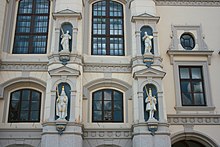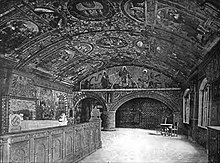Town hall Lueneburg
| Town hall Lueneburg | |
|---|---|
 Main facade facing the market, completed in 1720 |
|
| Data | |
| place | Luneburg |
| builder | unknown |
| Construction year | from 1230, expanded and rebuilt several times |
| Floor space | 5000 m² |
| Coordinates | 53 ° 15 '1.3 " N , 10 ° 24' 24.8" E |
| particularities | |
| In the tower there is a carillon made of Meissen porcelain . | |
The town hall of Lüneburg is an example of medieval and early modern secular architecture in northern Germany. It was built around 1230, has been expanded over the centuries and is still the headquarters of the council and administration of the Hanseatic city of Lüneburg today .
The Lüneburg town hall complex is surrounded by the streets Am Markt (east), Waagestraße (south), Am Marienplatz (west) and Am Ochsenmarkt (north). It is considered the largest medieval town hall in northern Germany. The most historically valuable parts (court arbor, prince's hall, mayor's corporation chamber, old archive and chancellery, large council chamber) can be viewed on guided tours.
Construction and equipment
The building ensemble consists of several building components that have been gradually expanded. Most of them belong to the North German brick Gothic, but the baroque facade was not completed until 1720 after the Gothic facade, damaged by a storm in 1703, was in danger of collapsing and was torn down.
The lower court was on the market side . Apart from the protection of the facade arcades, it is exposed so that the artistic design of the walls can be viewed freely. The protruding parts of the masonry are adorned with ten figures made of sandstone and partly gilded, which represent the following virtues or people: Severitas (= the strictness), Veritas (= the truth), Clementia , Gloriatur Adversus Iudicium, Prudencia , Iustinianus I , Carolus Magnus , Carolus V , Fredericus Z and Fridericus Rex .
In the octagonal tower with open sound arcades , a carillon made of Meissen porcelain with 41 bells is installed, which plays songs by the Lüneburg composer Johann Abraham Peter Schulz . In the morning at 8 o'clock is Erntelied to hear about 12 o'clock the harvest dance from the opera The Harvest Festival and 18 o'clock the evening song ( "The moon has risen").
The town hall of Lüneburg did not suffer any war damage, so that it is still equipped with magnificent art treasures to this day.
The court arbor is characterized by ceiling and wall paintings, from which a mural of the Master of the Last Judgment from the late 15th century protrudes. The floor of this room is still in its original state from the 14th century. The late Gothic window panes have also been preserved.
The Fürstensaal was used as a dance and reception hall. It is named after the late medieval wall paintings depicting the Lüneburg princes. The Fürstensaal is one of the largest column-free halls of its time. Today it is used for receptions, lectures and chamber concerts.
The large council chamber is furnished with rich oak carvings by Albert von Soest . The wall paintings are by Daniel Frese . The hall is considered a masterpiece of the Renaissance and is an example of how the citizens of Lüneburg followed fashion without destroying the old by repeatedly adding to the town hall.
The walled town hall garden faces Waagestrasse and can be accessed during the day.
Until 1874, the town hall contained the Lüneburg council silver , the largest preserved silver treasure in a German city. It is exhibited today in the Berlin Museum of Decorative Arts . Electroplated copies of the pieces can be seen in Lüneburg town hall today.
Redevelopment
The town hall is currently being completely renovated as part of a longer project, which also takes archaeological and architectural research into account. The repair of the entire building complex should be completed by 2024/25. As part of the master plan, the building services are also updated and adapted to modern requirements. The improvement of fire protection also plays an important role.
photos
Citizen oath crystal from Hans von Laffert from the Lüneburg council silver, now Berlin
Literature (selection)
- Wilhelm Behncke : Albert von Soest and the meeting room in the town hall of Lüneburg , inaugural dissertation to obtain the philosophical doctorate from a high philosophical faculty of the University of Heidelberg, Strasbourg: University printing house by JH Ed. Heitz (Heitz & Mündel), 1900; Digitized version of the Bavarian State Library
- Joachim Ganzert (Eds.), Bernd Adam , Michael A. Flechtner, Katrina Obert, Edgar Ring, Birte Rogacki-Thiemann, Hansjörg Rümelin, Gisela Jaacks, Barbara Uppenkamp: The Lüneburg City Hall. Results of the investigations from 2008 to 2011 (= contributions to the history of architecture and culture , volume 19), 3 volumes, title addition to volume 3: Results of the investigations 2012 to 2014 , Petersberg: Michael Imhof Verlag, 2014–2015, ISBN 978-3- 7319-0052-8





